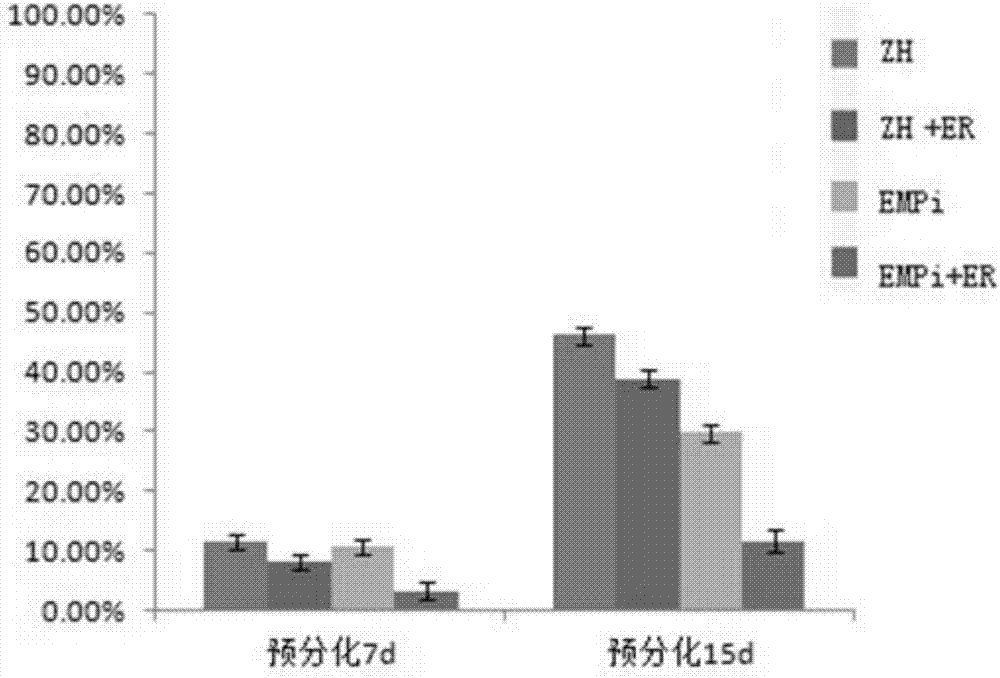Application of EMP gene in differentiation and development of rice callus
A technology of gene expression level and rice, which is applied in application, genetic engineering, plant gene improvement, etc., can solve the problems of low transformation efficiency, large impact on transformation efficiency, and large difference in callus regeneration ability, so as to improve the genetic transformation of rice. efficiency, improving transformation efficiency, and improving the effect of rice callus differentiation ability
- Summary
- Abstract
- Description
- Claims
- Application Information
AI Technical Summary
Problems solved by technology
Method used
Image
Examples
Embodiment 1
[0027] Example 1 Obtaining of RNA Interference Mutant Material of Rice Affecting Callus Differentiation Ability-Related Gene EMP
[0028] Design specific primers according to the sequence information of NCBI database Os05g0349800:
[0029] SEQ ID NO: 3:
[0030] CTAGTCGACTCTAGCCTCGAGATGGCGTCCGGGCAGCAG
[0031] SEQ ID NO: 4: ATCTGCTCCTTCCTCGTCT
[0032] SEQ ID NO: 5: GGAGGCCTGGATCGACTAGTATGGCGTCCGGGCAGCAG
[0033] SEQ ID NO: 6: AGACGAGGAAGGAGCAGATCTCGGCGAGGTTCTCCTG
[0034] Utilize the combination of primers SEQ ID NO: 3 and SEQ ID NO: 4 and the combination of SEQ ID NO: 5 and SEQ ID NO: 6 to amplify the two DNA fragments and use one-step construction of RNA interference carrier method (Jiang, et al., Planta. 2013. (238): 325-330) Construction of pER8 estrogen-inducible RNA interference vector (Zuo J, et al., 2000. 11(2): 146-151.). Zhonghua 11 was transformed by Agrobacterium-mediated transformation method, and a stable transgenic line was obtained. Compared with Zhonghua...
Embodiment 2
[0035] Example 2 Functional Identification of Genes Related to Rice Affecting Callus Differentiation Ability
[0036] 1. Rice RNA extraction and reverse transcription reaction
[0037] (1) Take about 0.5 g of rice (Zhonghua 11) tissue, put it into a pre-cooled mortar, add liquid nitrogen, grind it into powder, put it into a 2 mL centrifuge tube, add 1000 μL RNA extraction buffer and 200 μL chloroform, mix well, and bathe in water at 65°C for 5 minutes;
[0038] (2) Centrifuge at 12,000 rpm for 12 minutes, transfer the supernatant to another 1.5mL centrifuge tube, add 0.6 times the volume of isopropanol or twice the volume of absolute ethanol, mix well, 12,000 rpm Centrifuge for 12 minutes, remove the supernatant, rinse twice with 0.5ml 70% ethanol, air dry, and dissolve in 20 μL DEPC water;
[0039] (3) Take 1 μL of RNA for PCR reverse transcription reaction to synthesize the first strand of reverse transcription cDNA (15 μL). The reaction system is: 1 μL of DNase-treated to...
Embodiment 3
[0063] Example 3 Functional Verification of Genes Affecting Rice Callus Differentiation Ability
[0064] Estrogen is used to induce the expression of RNA interference products and destroy the gene sequence of SEQ ID NO: 1 in rice. Real-time quantitative RT-PCR detection showed that the mRNA expression level decreased, and the pre-differentiation ability of estrogen-treated RNAi interference mutants decreased significantly.
[0065] The functional verification of genes related to rice callus differentiation ability includes the following steps:
[0066] (1) Using estrogen-induced expression vectors to construct RNA interference vectors for genes related to rice callus differentiation ability, and transform Zhonghua 11 through Agrobacterium-mediated transformation and identify homozygous transgenic T2 generation materials.
[0067] (2) The seeds of Zhonghua 11 and RNA interference transgenic materials affecting rice callus differentiation ability-related genes were used to indu...
PUM
 Login to View More
Login to View More Abstract
Description
Claims
Application Information
 Login to View More
Login to View More - R&D
- Intellectual Property
- Life Sciences
- Materials
- Tech Scout
- Unparalleled Data Quality
- Higher Quality Content
- 60% Fewer Hallucinations
Browse by: Latest US Patents, China's latest patents, Technical Efficacy Thesaurus, Application Domain, Technology Topic, Popular Technical Reports.
© 2025 PatSnap. All rights reserved.Legal|Privacy policy|Modern Slavery Act Transparency Statement|Sitemap|About US| Contact US: help@patsnap.com


